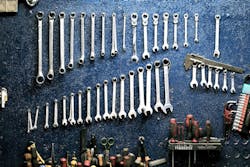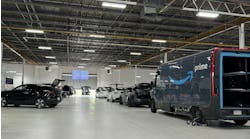SHOP STATS: Kilkeary's Auto Body Location: Washington County, Pa. Operator: Tim Kilkeary Average Monthly Car Count: 115-180 Staff Size: 30 Shop Size: 15,000 square feet Annual Revenue: $5.5 million
When Tim Kilkeary looked around his Washington County, Pa., shop, he saw frame equipment with no measuring system.
He saw how there was no way for the shop to measure the straightening of the frame and document it.
He saw a spray booth so old that if it broke down, it would not be functional for days while the shop waited to receive a part for the equipment repair.
It was 2012. Kilkeary had finally paid off his purchase of the $5.5 million Kilkeary Auto Body and the property on which it sits. He learned the family business from his dad and worked his way up through the shop to become the day-to-day manager.
But, when he took over the operations fully, he realized the building and the shop equipment was outdated.
Kilkeary decided to create a five-year capital reinvestment plan in order to revamp the shop and get it up to modern-day standards.
But, the plan was not easy.
In order to successfully redo the shop and make investments, Kilkeary tackled common implementation traps and came out on the other side—facing a facility that will not need improvements for the next 20 years.
The Backstory
Around 1986, Kilkeary started working as the shop’s foreman. The shop continued to grow and by that time there was a full staff of three body men, he says.
As the shop continued to grow, updates to the facility were made, turning it into a 15,000-square-foot facility in 1995.
Those were the shop’s last updates.
After deciding to buy the business outright in 2007, Kilkeary paid off the shop that he purchased from his father over a period of roughly five years. Once he finished paying off the purchase in 2012, he realized he had just been able to make a big financial move that not only benefited him but also the staff, who were now under new management.
The Problem
Paying that debt off was a huge step for Kilkeary, and the massive benefit to paying it off was it motivated him to look at other areas of the business. The company’s infrastructure was 20 years old. The frame equipment alone had no measuring system, and thus, no ability to document whether a structural repair was correct or not, Kilkeary says.
The shop also had one spray booth that had been well maintained and still worked but was outdated. Due to the age of the equipment, the maintenance company would not be able to complete repairs on the equipment. Parts for the outdated machine could not be acquired, he says.
Kilkeary says he was also pressured by being surrounded by nicer and more modern dealerships. Part of the shop’s organic growth came from the partnerships it established with those nine dealerships, which meant it needed to keep up with their expectations.
“My idea was to continue to increase sales and gain organic growth of whatever it might be, either through our dealership partners or customers,” he says.
Suddenly, it seemed that his shop no longer met the expectations of both customers and dealership partners, and that he needed to upgrade the shop—without incurring significant debt.
The Solution
With the help of his business coach, Kilkeary put into motion a five-year capital reinvestment plan in in 2013 in order to update the facility and the shop’s equipment. First, he sat down with his business coach and created five stages of investment. The budget was created from taking a past look at the shop’s history of sales and gross profit. Kilkeary was able to project based off on past profit, how much he could take out of the business’ savings account to spend, which would then be made up in sales by the end of the year. Each stage involved an investment of about $150,000 or more so he spread out the plan to occur over a few years.
The plan was two-pronged, Kilkeary says. He first needed to determine the most urgent need for updates in the shop and then determine the equipment he would purchase. The larger chunk of time was spent planning how much he would spend for each stage and for the equipment.
Kilkeary spent about a year researching equipment and tools through Google searches, attending trade shows and talking with his local jobber and suppliers. He attended the SEMA Show in Las Vegas each year and reached out to companies in Cleveland, to discuss the possible spray booths and frame equipment. To determine how much money to invest in the new tooling and remodeling, he consulted his accountant and looked at his previous profit and loss statements.
Once Kilkeary knew what his profit was, he could take that number and project the gross sales for the business, he says.
The First Stage: The first step was to update the old frame equipment, he says. The frame equipment was replaced by Car-O-Liner equipment that cost $150,000. To update the tools, time was spent moving the equipment and training employees on the new installment.
The Second Stage: Then, two spray booths were added to the shop. Each Blowtherm spray booth cost $125,000. In order to add the two new spray booths, Kilkeary needed to shift departments and equipment around.
The space was cramped so Kilkeary invested another $150,000 in taking the roof off and placing a higher ceiling in the shop.
The Third Stage: In 2017, the shop’s entire front office was remodeled. Kilkeary hired a local architect and designer from the company Integrity Design and revamped the old ’90s decor.
Walls were knocked out and replaced with glass to look over the parking lot. Every piece of furniture and decoration was completely brand new. The total remodel cost $300,000 including construction, Kilkeary says.
While the office was being remodeled, Kilkeary moved his seven administrative staff to a trailer that was rented. Due to the team looking ahead at the outcome of the construction and not internally at the “frustrating” process, Kilkeary only had one customer complain about the inconvenience, he says.
The Fourth Stage: Throughout these years, Kilkeary not only worked on updating the existing facility but also on purchasing some land next to the shop.
The shop is situated on a hill in Eighty Four, Pa. Kilkeary says the building was essentially backed into a cliff and offered little to no room for expanding the body shop. Instead of working against the hill and building a new location, Kilkeary worked to remodel areas that could make access to work easier for his employees.
In 2017, he purchased 10 acres of the vacant lot next door in order to install a parking lot for his staff of 30 people. Before the purchase, his staff had to park three-quarters of a mile away from the shop and up the hill.
The property cost about $400,000.
The Fifth Stage: In late May 2018, Kilkeary finished repaving the new parking lot. The lot now can hold roughly 30 cars to accommodate his staff and provide them “flat” ground to the shop. In total, repavement cost $150,000.
The Aftermath
At the end of the process, Kilkeary says he has cut down on the number of production stops the staff experiences and reduced needed maintenance on tools and equipment by 60 percent.
Overall, the process did not go down without hiccups. When Kilkeary installed new frame equipment, his older technician saw no need for one that had a built-in measuring system, he says. At the time, his technician was close to retiring and had many years experience in the industry without using new technology. To make the process go smoother, Kilkeary brought in a younger technician to help train his older employee and eventually had the younger worker take over that job. He transitioned the other employee to another area of the shop that was not framework.
To top it off, there will be no unforeseen investments in his immediate future as owner.
The Takeaway
“This process has given me peace of mind,” Kilkeary says. “I get to explain to a future employee, current employee or bank that our updates have all been paid for.”
He says he does not need to worry about working tools and equipment investments into each yearly budget.
Expert Advice : The Financial Take
Michael Milos, CFO of Cole’s Collision Centers, shares three important tips for properly approaching a large financial investment.
Tip 1: Plan ahead for a return.
Milos says an owner should plan in advance to gain a return on the investment he or she makes.
“Just because something seems cheap doesn’t mean you’ll necessarily have a return in order to cover your expenses,” he says.
To make sure the business comes out on top of an investment with a profit, Milos says to look at this calculation: the estimated amount of volume of collision repair minus your overhead and dedicated equipment expenses (including payroll).
Tip 2: Start to plan a year in advance.
Typically for a large investment like purchasing a new facility, the owner should plan a year ahead, Milos says. A significant amount of time is spent training management and grooming technicians.
For the example of purchasing a new shop, Milos says the greatest hurdle will be fully staffing the building along with keeping insurance contracts and stream of work.
Tip 3: Look at how much capital you need.
Milos says that if an owner needs to take a loan out for the project, he or she should spend time looking at capital he or she needs to produce at the end.
Once that is established, the owner can look further in the area to see if anything is offered for industrial development, small business assistance or minority programs. If those are not available, the owner needs to look at a straight bank loan, Milos says.



